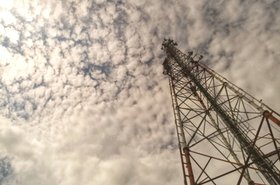Amazon Web Services is down again, in its third outage this month.
There is a problem with AWS at its US-East-1 (Virginia) cloud region, impacting a number of customers and users. Among those impacted are Coinbase, Fortnite, Hulu, Instacart, Rocket League, Acadly, Peloton, Hinge, Quora, the Epic Games Store, Slack, GitHub rival Bitbucket, Samsung Smart Lights, Asana, and Imgur.
The company has confirmed that the problem is due to a power outage at one of its data centers in Virginia. At 5:39AM PST, AWS said it had returned power to the facility, and expected services to return soon - however it may take longer for end users to fix their own services.
The AWS Status Page does not currently show any current errors, but says that there was an issue with the Elastic Beanstalk console in multiple Regions earlier today that has since been resolved. AWS EC2 users report receiving messages saying: "An error occurred fetching instance data: An unknown error occurred."
Update: Amazon added the following to its status page: "4:35 AM PST We are investigating increased EC2 launched failures and networking connectivity issues for some instances in a single Availability Zone (USE1-AZ4) in the US-EAST-1 Region. Other Availability Zones within the US-EAST-1 Region are not affected by this issue."
Update 2: "5:01 AM PST We can confirm a loss of power within a single data center within a single Availability Zone (USE1-AZ4) in the US-EAST-1 Region. This is affecting availability and connectivity to EC2 instances that are part of the affected data center within the affected Availability Zone. We are also experiencing elevated RunInstance API error rates for launches within the affected Availability Zone. Connectivity and power to other data centers within the affected Availability Zone, or other Availability Zones within the US-EAST-1 Region are not affected by this issue, but we would recommend failing away from the affected Availability Zone (USE1-AZ4) if you are able to do so. We continue to work to address the issue and restore power within the affected data center."
Update 3: "5:18 AM PST We continue to make progress in restoring power to the affected data center within the affected Availability Zone (USE1-AZ4) in the US-EAST-1 Region. We have now restored power to the majority of instances and networking devices within the affected data center and are starting to see some early signs of recovery. Customers experiencing connectivity or instance availability issues within the affected Availability Zone, should start to see some recovery as power is restored to the affected data center. RunInstances API error rates are returning to normal levels and we are working to recover affected EC2 instances and EBS volumes. While we would expect continued improvement over the coming hour, we would still recommend failing away from the Availability Zone if you are able to do so to mitigate this issue."
Update 4: "5:39 AM PST We have now restored power to all instances and network devices within the affected data center and are seeing recovery for the majority of EC2 instances and EBS volumes within the affected Availability Zone. Network connectivity within the affected Availability Zone has also returned to normal levels. While all services are starting to see meaningful recovery, services which were hosting endpoints within the affected data center - such as single-AZ RDS databases, ElastiCache, etc. - would have seen impact during the event, but are starting to see recovery now. Given the level of recovery, if you have not yet failed away from the affected Availability Zone, you should be starting to see recovery at this stage."
Update 5: "6:13 AM PST We have now restored power to all instances and network devices within the affected data center and are seeing recovery for the majority of EC2 instances and EBS volumes within the affected Availability Zone. We continue to make progress in recovering the remaining EC2 instances and EBS volumes within the affected Availability Zone. If you are able to relaunch affected EC2 instances within the affected Availability Zone, that may help to speed up recovery. We have a small number of affected EBS volumes that are still experiencing degraded IO performance that we are working to recover. The majority of AWS services have also recovered, but services which host endpoints within the customer’s VPCs - such as single-AZ RDS databases, ElasticCache, Redshift, etc. - continue to see some impact as we work towards full recovery."
Update 6: "6:51 AM PST We have now restored power to all instances and network devices within the affected data center and are seeing recovery for the majority of EC2 instances and EBS volumes within the affected Availability Zone. For the remaining EC2 instances, we are experiencing some network connectivity issues, which is slowing down full recovery. We believe we understand why this is the case and are working on a resolution. Once resolved, we expect to see faster recovery for the remaining EC2 instances and EBS volumes. If you are able to relaunch affected EC2 instances within the affected Availability Zone, that may help to speed up recovery. Note that restarting an instance at this stage will not help as a restart does not change the underlying hardware. We have a small number of affected EBS volumes that are still experiencing degraded IO performance that we are working to recover. The majority of AWS services have also recovered, but services which host endpoints within the customer’s VPCs - such as single-AZ RDS databases, ElasticCache, Redshift, etc. - continue to see some impact as we work towards full recovery."
Update 7: "8:02 AM PST Power continues to be stable within the affected data center within the affected Availability Zone (USE1-AZ4) in the US-EAST-1 Region. We have been working to resolve the connectivity issues that the remaining EC2 instances and EBS volumes are experiencing in the affected data center, which is part of a single Availability Zone (USE1-AZ4) in the US-EAST-1 Region. We have addressed the connectivity issue for the affected EBS volumes, which are now starting to see further recovery. We continue to work on mitigating the networking impact for EC2 instances within the affected data center, and expect to see further recovery there starting in the next 30 minutes. Since the EC2 APIs have been healthy for some time within the affected Availability Zone, the fastest path to recovery now would be to relaunch affected EC2 instances within the affected Availability Zone or other Availability Zones within the region."
Update 8: "9:28 AM PST We continue to make progress in restoring connectivity to the remaining EC2 instances and EBS volumes. In the last hour, we have restored underlying connectivity to the majority of the remaining EC2 instance and EBS volumes, but are now working through full recovery at the host level. The majority of affected AWS services remain in recovery and we have seen recovery for the majority of single-AZ RDS databases that were affected by the event. If you are able to relaunch affected EC2 instances within the affected Availability Zone, that may help to speed up recovery. Note that restarting an instance at this stage will not help as a restart does not change the underlying hardware. We continue to work towards full recovery."
Update 9: AWS is separately "investigating increased error rates for some customers using Directory Services AD Connector or Managed AD with Amazon SSO in US-EAST-1 Region. Customers using other Active Directory functionality are not impacted at this time."
The outage follows a significant outage at AWS' Northern Virginia (US-East-1) region in early December. That outage took out everything from Disney+, to Tinder, to Amazon's own warehouse logistics network. The outage was due to “automated activity” that triggered “unexpected behavior” in its internal network.
That was followed by a mid-December outage impacting the US-West-2 region in Oregon and US-West-1 in Northern California, which was due to undisclosed "Internet connectivity" issues.
In between the two outages, AWS' home page briefly went offline. The company did not disclose what caused that small outage, with a representative from the company telling DCD that it did not happen.
"While we are proud of our track record of availability, we know how critical our services are to our customers, their applications and end-users, and their businesses," AWS said following the first outage. "We know this event impacted many customers in significant ways. We will do everything we can to learn from this event and use it to improve our availability even further."
This story is developing




